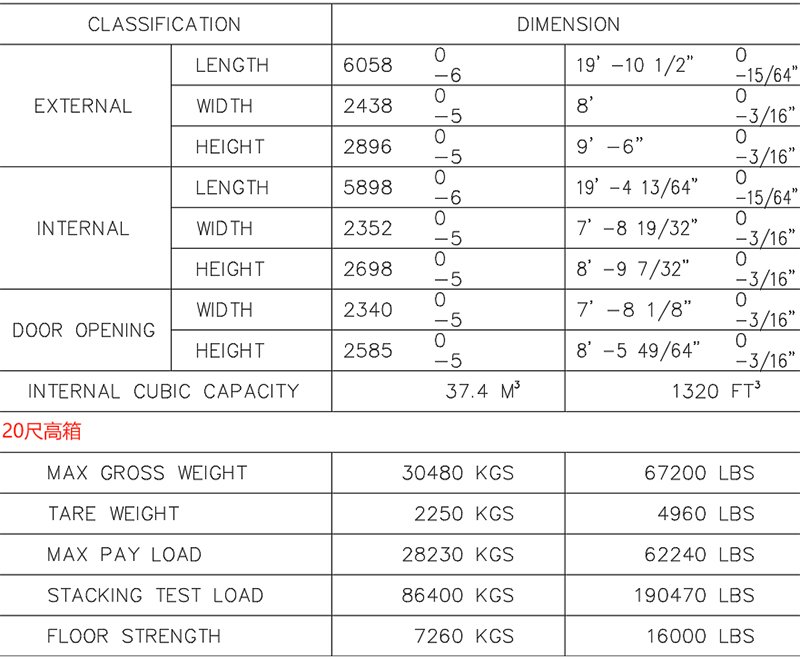The 20-foot high cube container is a highly practical and versatile solution in the world of logistics, storage, and various other applications. This article will provide you with a comprehensive understanding of its key aspects, including specifications, materials, construction, and usage scenarios.
1. Specifications
External Dimensions: The length of a 20-foot high cube container is precisely 20 feet (equivalent to 6.058 meters). The width is 8 feet (2.438 meters), and what distinguishes it from the standard 20-foot container is its height. It has an external height of 9 feet 6 inches (2.896 meters), which allows for a significantly larger internal volume.
Internal Dimensions: Internally, the length is approximately 19 feet 4 inches (5.892 meters), the width is around 7 feet 8 inches (2.34 meters), and the height is 8 feet 10 inches (2.692 meters). This increased height provides an extra amount of usable space compared to the regular 20-foot container, making it more suitable for accommodating taller or bulkier items.
Volume and Payload Capacity: With its larger internal dimensions, it typically offers a volume of around 1,172 cubic feet (33.2 cubic meters). In terms of payload capacity, it usually can carry a maximum payload ranging from 26,000 to 30,000 kilograms, depending on the specific design and manufacturing standards, enabling the transportation of relatively heavy goods.
Door Dimensions: The container is equipped with a single set of doors at one end. The door opening usually has a width of about 7 feet 8 inches (2.34 meters) and a height of 8 feet 6 inches (2.591 meters). This size allows for convenient loading and unloading of cargo, even for larger items.
2. Materials and Construction
Frame: The frame of the 20-foot high cube container is constructed from high-strength steel. This steel is carefully selected for its excellent tensile strength and durability. It is treated with anti-corrosion coatings to withstand various weather conditions and the rigors of transportation, such as exposure to saltwater during maritime shipping or extreme temperatures on land. The frame provides the overall structural support, ensuring that the container can bear heavy loads and withstand stacking pressures when stored or transported in multiple layers.
Wall and Roof Panels: The walls and roof are made of corrugated steel sheets. The corrugated design not only adds to the aesthetic appeal but also significantly enhances the structural strength of the container. These sheets are firmly attached to the frame and are capable of withstanding external impacts and pressure. They also serve as a reliable barrier against the elements, protecting the contents inside from rain, wind, sunlight, and other environmental factors.
Floor: The floor is typically composed of marine-grade plywood or a combination of hardwood and steel reinforcements. Marine-grade plywood is resistant to moisture and fungal growth, which is essential given the container's potential exposure to humid conditions during transportation or storage. The steel reinforcements provide additional strength to support heavy cargo, preventing the floor from sagging or getting damaged under the weight of the goods.
Doors: The doors are made of steel and are attached to the frame using heavy-duty hinges. They are equipped with reliable locking mechanisms, often including multiple locking points and a sturdy crossbar system, to ensure the security of the cargo during transit. The door seals are made of high-quality rubber or other flexible materials to create a tight seal, preventing the ingress of water, dust, and air, thus protecting the contents from damage and maintaining the integrity of the internal environment.
3. Usage Scenarios
Logistics and Transportation: It is widely used in the shipping industry for transporting a diverse range of goods. Due to its larger internal height, it is particularly suitable for items that are taller or have irregular shapes, such as large machinery, industrial equipment, furniture sets, and building materials. The ability to stack these containers on ships, trains, or trucks makes it an efficient choice for long-distance transportation, facilitating global trade and the movement of goods between different regions.
Storage: Serves as an excellent storage solution for both commercial and personal use. Businesses can use it to store inventory, equipment, or archived documents. For homeowners, it can be a convenient option for storing seasonal items, sports equipment, or household goods during renovations or when additional storage space is needed. The weatherproof and secure nature of the container ensures that the stored items are well protected.
Temporary Workspaces or Retail Outlets: Can be converted into temporary offices, workshops, or small retail stores. With some interior modifications like adding insulation, electrical wiring, lighting, and shelving, it becomes a functional and mobile workspace. In the retail sector, it can be set up at festivals, trade shows, or in areas with high foot traffic to display and sell products, providing a unique and eye-catching shopping experience.
Disaster Relief and Emergency Response: In times of natural disasters or emergencies, these containers can be quickly deployed to affected areas. They can be used to store and transport essential supplies such as food, water, medical equipment, and shelter materials. Their durability and ability to be easily transported and positioned make them a valuable asset in providing immediate assistance and support to those in need.





